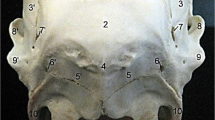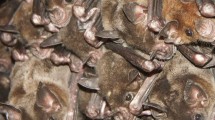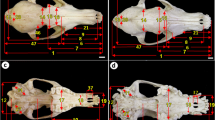Abstract
The domestic dog (Canis lupus familiaris) shows a high intraspecific morphological diversity in its facial shape with a less well-known effect of different snout length types on the intranasal structures, i.e. the turbinal skeleton. Sighthounds are supposed to have a less developed sense of smell in favor of their visual abilities. It has been proposed that within the small space of a sighthound’s slender snout the turbinals are less in number and reduced. In a recent ethological study the English greyhound failed at an odor-discrimination task. To test this hypothesis we performed a morphological and morphometric analysis of the turbinal skeleton in the borzoi as a member of the sighthound group based on high resolution computed tomography. For comparison we included saluki, German shepherd and Eurasian wolf in our study; borzoi and German shepherd are represented by different ontogenetic stages. Histological serial sections of a prenatal whippet were investigated to confirm identification of single turbinals. In order to elucidate the proportions and complexity of the turbinal skeleton we applied a new morphometric approach. Our results clearly show no significant difference in the number of turbinals in all investigated specimens but an unexpected high number of interturbinals in the sighthounds in comparison to the German shepherd and the wolf, a large surface area and a high surface density and turbinal complexity. Consequently, the turbinal morphology of the borzoi and most probably the sighthound group in general clearly shows no skeletal evidence for a reduced olfactory sense. Thus, our study demonstrates that the bony turbinals alone cannot provide a proxy for olfactory abilities in dogs. The epithelium, the olfactory receptors with their corresponding genes, the brain, and the ethology need to be considered as well when analyzing a species’ olfactory performance.
Similar content being viewed by others
Abbreviations
- AE:
-
exterior surface area
- ALB:
-
area of length and breadth of snout
- AT:
-
turbinal surface area
- BOR:
-
borzoi
- BZB:
-
bizygomatic breadth
- C:
-
upper canine
- DOL:
-
dolichocephalic
- dP2-4:
-
deciduous upper premolar 2-4
- ep:
-
epiturbinal of eth-moturbinal I
- et:
-
ethmoturbinal
- etr:
-
ethmoturbinal recess
- EW:
-
Eurasian wolf
- f:
-
frontal
- ft:
-
frontoturbinal
- ftr:
-
frontoturbinal recess
- GLS:
-
greatest length of skull
- GSD:
-
German shepherd
- IAE:
-
index exterior surface area
- IAT:
-
index turbinal surface area
- IBL:
-
index breadth to length of skull
- IFB:
-
index facial length to length of braincase
- IOB:
-
interorbital breadth
- it:
-
interturbinal
- it:
-
prominent interturbinal homologous between all individuals
- j:
-
jugal
- lac:
-
lacrimal
- LBC:
-
length of braincase
- lh:
-
lamina horizontalis
- LPII:
-
length of palate II
- ls:
-
lamina semicircularis
- lt:
-
lamina terminalis
- ltp:
-
lamina transversalis posterior
- lv:
-
lamina verticalis
- M1-2:
-
upper molar 1-2
- MES:
-
mesaticephalic
- [MfN]:
-
alternative labelling of mammal collection at Museum für Naturkunde Berlin, Germany
- MNHN:
-
Muséum national d’Histoire naturelle, Paris, France
- mt:
-
maxilloturbinal
- mx:
-
maxillary
- mxr:
-
maxillary recess
- mxs:
-
maxillary sinus
- n:
-
nasal
- NMBE:
-
Naturhistorisches Museum der Burgergemeinde Bern, Switzerland
- nd:
-
nasopharyngeal duct
- NLII:
-
nasal length II
- ns:
-
nasal septum
- nt:
-
nasoturbinal
- P2-4:
-
upper premolar 2-4
- pa:
-
pars anterior(etI)
- pl:
-
palate
- pmx:
-
praemaxillary
- pn:
-
paries nasi
- pp:
-
pars posterior(etI)
- upr:
-
uncinate process
- SDEN:
-
surface density
- SMF:
-
Senckenberg Forschungsinstitut und Naturmuseum Frankfurt, Germany
- TC:
-
turbinal complexity
- tn:
-
tectum nasi
- WH:
-
whippet
- ZMBMAM:
-
mammal collection of Museum für Naturkunde Berlin, Germany
References
Ash, E.C., 1927. Dogs: Their History and Development, vol I. Ernest Benn Limited, London.
Baron, G., Frahm, H.D., Bhatnagar, K.P., Stephan, H., 1983. Comparison of brain structure volumes in Insectivora and Primates. III. Main olfactory bulb (MOB). J. Hirnforsch. 24, 551–568.
Beckmann, L., 1894. Geschichte und Beschreibung der Rassen des Hundes. Bd. I. Druck und Verlag von Friedrich Bieweg und Sohn, Braunschweig.
Brehm, A.E., 1876. Brehms Thierleben. Allgemeine Kunde des Thierreichs. Bibliographisches Institut, Leipzig.
Burk, R.L., 1992a. Computed tomographic anatomy of the canine nasal passages. Vet. Radiol. Ultrasoun. 33, 170–176.
Burk, R.L., 1992b. Computed tomographic imaging of nasal disease in 100 dogs. Vet. Radiol. Ultrasoun. 33, 177–180.
Craven, B.A., Neuberger, T., Paterson, E.G., Webb, A.G., Josephson, E.M., Morrison, E.E., Settles, G.S., 2007. Reconstruction and morphometric analysis of the nasal airway of the dog (Canis familiaris) and implications regarding olfactory airflow. Anat. Rec. 290, 1325–1340.
Craven, B.A., Paterson, E.G., Settles, G.S., 2010. The fluid dynamics of canine olfaction: unique nasal airflow patterns as an explanation of macrosmia. J. Roy. Soc. Interface 7, 933–943.
Ellenberger, W., Baum, H., 1891. Systematische und topographische Anatomie des Hundes. Paul Parey, Berlin, Hamburg.
Finck, M., Ponce, F., Guilbaud, L., Chervier, C., Floch, F., Cadore, J.L., Chuzel, T., Hugonnard, M., 2015. Computed tomography or rhinoscopy as the first-line procedure for suspected nasal tumor: a pilot study. Can. Vet. J. 56, 185–192.
Green, P.A., Van Valkenburgh, B., Pang, B., Bird, D., Rowe, T., Curtis, A., 2012. Respiratory and olfactory turbinal size incanid and arctoid carnivorans. J. Anat. 221, 609–621.
Guagnin, M., Perri, A.R., Petraglia, M.D., 2018. Pre-Neolithic evidence for dog-assisted hunting strategies in Arabia. J. Anthropol. Archaeol. 49, 225–236.
Hall, N.J., Glenn, K., Smith, D.W., Wynne, C.D., 2015. Performance of Pugs, German Shepherds, and Greyhounds (Canis lupus familiaris) on an odor-discrimination task. J. Comp. Psychol. 129, 237–246.
Hillenius, W.J., 1992. The evolution of nasal turbinates and mammalian endothermy. Paleobiology 18, 17–29.
Hillenius, W.J., 1994. Turbinates intherapsids — evidence for late permian origins of mammalian endothermy. Evolution 48, 207–229.
Hofer, H., 1952. Der Gestaltwandel des Schädels der Säugetiere und Vögel, mit besonderer Berücksichtigung der Knickungstypen und der Schädelbasis. Verh. Anat. Ges. 50, 102–113.
Issel-Tarver, L., Rine, J., 1996. Organization and expression of canine olfactory receptor genes. Proc. Natl. Acad. Sci. U. S. A. 93, 10897–10902.
Kuhn, H.J., 1971. Die Entwicklung und Morphologie des Schädels von Tachyglossus aculeatus. Abh. senckenb. naturforsch. Ges. 528, 1–224.
Lesniak, A., Walczak, M., Jezierski, T., Sacharczuk, M., Gawkowski, M., Jaszczak, K., 2008. Canine olfactory receptor gene polymorphism and its relation to odor detection performance by sniffer dogs. J. Hered. 99, 518–527.
Macrini, T.E., 2012. Comparative morphology of the internal nasal skeleton of adult marsupials based on X-ray computed tomography. B. Am. Mus. Nat. Hist. 365, 1–91.
Maier, W., Ruf, I., 2014. Morphology of the nasal capsule of primates — with special reference to Daubentonia and Homo. Anat. Rec. 297, 1985–2006.
Mazák, J.H., 2010. Geographical variation and phylogenetics of modern lions based on craniometric data. J. Zool. 281, 194–209.
McGreevy, P., Grassi, T.D., Harman, A.M., 2004. A strong correlation exists between the distribution of retinal ganglion cells and nose length in the dog. Brain Behav. Evol. 63, 13–22.
Mech, L.D., 1974. Canis lupus. Mamm. Species 37, 1–6.
Oechtering, G.U., Pohl, S., Schlueter, C., Lippert, J.P., Alef, M., Kiefer, I., Ludewig, E., Schuenemann, R., 2016. A novel approach to brachycephalic syndrome. 1. Evaluation of anatomical intranasal airway obstruction. Vet. Surg. 45, 165–172.
Pang, B., Yee, K.K., Lischka, F.W., Rawson, N.E., Haskins, M.E., Wysocki, C.J., Craven, B.A., Van Valkenburgh, B., 2016. The influence of nasal airflow on respiratory and olfactory epithelial distribution in felids. J. Exp. Biol. 219, 1866–1874.
Paulli, S., 1900a. Über die Pneumaticität des Schädels bei den Säugetieren. Eine morphologische Studie. I. Über den Bau des Siebbeins. Über die Morphologie des Siebbeins und die Pneumaticität bei den Monotremen und den Marsupialiern. Morphol. Jb. 28, 147–178.
Paulli, S., 1900b. Über die Pneumaticität des Schädels bei den Säugetieren. Eine morphologische Studie. II. Über die Morphologie des Siebbeins und der Pneumaticität bei den Ungulaten und Probosciden. Morphol. Jb. 28, 179–251.
Paulli, S., 1900c. Über die Pneumaticität des Schädels bei den Säugetieren. Eine morphologische Studie. III. Über die Morphologie des Siebbeins und die Pneumaticität bei den Insectivoren, Hyracoideen, Chiropteren, Carnivoren, Pinnipeden, Edentaten, Rodentiern, Prosimiern und Primaten, nebst einer zusammenfassenden Übersicht über die Morphologie des Siebbeins und die der Pneumaticität des Schädels bei den Säugetieren. Morphol.Jb. 28, 483–564.
Quignon, P., Rimbault, M., Robin, S., Galibert, F., 2012. Genetics of canine olfaction and receptor diversity. Mamm. Genome 23, 132–143.
R Core Team, 2016. R: A Language and Environment for Statistical Computing. R Foundation for Statistical Computing, Vienna, Austria.
Reinbach, W., 1952a. Zur Entwicklung des Primordialcraniums von Dasypus novemcinctus LINNÉ (Tatusia novemcincta LESSON) I. Z. Morphol. Anthropol. 44, 375–444.
Reinbach, W., 1952b. Zur Entwicklung des Primordialcraniums von Dasypus novemcinctus LINNÉ (Tatusia novemcincta LESSON) II. Z. Morphol. Anthropol. 45, 1–72.
Robin, S., Tacher, S., Rimbault, M., Vaysse, A., Dréano, S., André, C., Hitte, C., Galibert, F., 2009. Genetic diversity of canine olfactory receptors. BMC Genomics 10, 21.
Rowe, T.B., Eiting, T.P., Macrini, T.E., Ketcham, R.A., 2005. Organization of the olfactory and respiratory skeleton in the nose of the gray short-tailed Opossum Monodelphis domestica. J. Mamm. Evol. 12, 303–336.
Ruf, I., 2004. Vergleichend-ontogenetische Untersuchungen an der Ethmoidalregion der Muroidea (Rodentia, Mammalia). Ein Beitrag zur Morphologie und Systematik der Nagetiere. Dissertation. Eberhard-Karls-Universität Tübingen, pp. 1–301 https://doi.org/nbn-resolving.de/urn:nbn:de:bsz:21-opus-13618.
Ruf, I., 2014. Comparative anatomy and systematic implications of the turbinal skeleton in Lagomorpha (Mammalia). Anat. Rec. 297, 2031–2046.
Ruf, I., Janßen, S., Zeller, U., 2015. The ethmoidal region of the skull ofPtilocerus lowii (Ptiloceridae, Scandentia, Mammalia) — a contribution to the reconstruction ofthe cranial morphotype of primates. Primate Biol. 2, 89–110.
Schliemann, H., 1966. Zur Morphologie und Entwicklung des Craniums von Canis lupus f. familiaris L. Morphol.Jb. 109, 501–603.
Schreider, J.P., Raabe, O.G., 1981. Anatomy ofthe nasal-pharyngeal airway of experimental animals. Anat. Rec. 200, 195–205.
Smith, T.D., Rossie, J.B., 2008. Nasal fossa of mouse and dwarf lemurs (Primates, Cheirogaleidae). Anat. Rec. 291, 895–915.
Smith, T.D., Bhatnagar, K.P., Tuladhar, P., Burrows, A.M., 2004. Distribution of olfactory epithelium in the primate nasal cavity: are microsmia and macrosmia valid morphological concepts? Anat. Rec. 281, 1173–1181.
Smith, T.D., Bhatnagar, K.P., Rossie, J.B., Docherty, B.A., Burrows, A.M., Cooper, G.M., Mooney, M.P., Siegel, M.I., 2007. Scaling ofthe first ethmoturbinal in nocturnal strepsirrhines: olfactory and respiratory surfaces. Anat. Rec. 290, 215–237.
Tacher, S., Quignon, P., Rimbault, M., Dreano, S., Andre, C., Galibert, F., 2005. Olfactory receptor sequence polymorphism within and between breeds of dogs. J. Hered. 96, 812–816.
Van Valkenburgh, B., Theodor, J., Friscia, A., Pollack, A., Rowe, T., 2004. Respiratory turbinates of canids and felids: a quantitative comparison. J. Zool. 264, 281–293.
Van Valkenburgh, B., Pang, B., Bird, D., Curtis, A., Yee, K., Wysocki, C., Craven, B.A., 2014. Respiratory and olfactory turbinals in feliform and caniform carnivorans: the influence of snout length. Anat. Rec. 297, 2065–2079.
Voit, M., 1909. Das Primordialcranium des Kaninchens unter Berücksichtigung der Deckknochen. Ein Beitrag zur Morphologie des Säugetierschädels. Anat. Hefte 38, 425–616.
vom Hagen, A., 1935. Die Hunderassen. Ein Handbuch für Hundeliebhaber und Züchter. Akademische Verlagsgesellschaft Athenaion M.B.H., Potsdam.
Yang, M., Geng, G.J., Zhang, W., Cui, L., Zhang, H.X., Zheng, J.L., 2016. SNP genotypes of olfactory receptor genes associated with olfactory ability in German Shepherd dogs. Anim. Genet. 47, 240–244.
Young, A., Bannasch, D., 2006. Morphological variation in the dog. In: Ostrander, E., Giger, U., Lindblad-Toh, K. (Eds.), The Dog and its Genome. Cold Springer Harbor Laboratory Press, New York, pp. 47–65.
Zeller, U., 1983. Zur Ontogenese und Morphologie des Craniums von Tupaia belangeri (Tupaiidae, Scandentia, Mammalia). Dissertation. Georg-August-Universitaet zu Goettingen, pp. 1–308.
Zeller, U., 1989. Die Entwicklung und Morphologie des Schädels von Ornithorhynchus anatinus (Mammalia: Protheria: Monotremata). Abh. Senckenberg. Naturforsch. Ges. 545, 1–188.
Author information
Authors and Affiliations
Corresponding author
Rights and permissions
About this article
Cite this article
Wagner, F., Ruf, I. Who nose the borzoi? Turbinal skeleton in a dolichocephalic dog breed (Canis lupus familiaris). Mamm Biol 94, 106–119 (2019). https://doi.org/10.1016/j.mambio.2018.06.005
Received:
Accepted:
Published:
Issue Date:
DOI: https://doi.org/10.1016/j.mambio.2018.06.005




